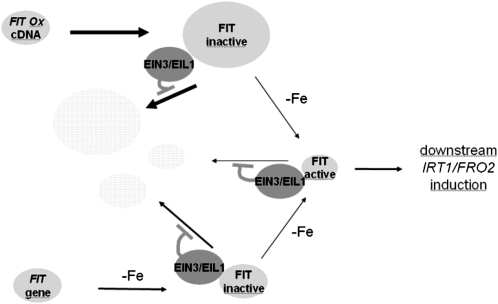Figure 8.
Model Explaining the Interaction between FIT and EIN3/EIL1.
FIT is produced in root cells upon –Fe in wild-type plants or, alternatively, independently of Fe supply in transgenic FIT Ox plants (FIT gene, FIT Ox construct, and FIT protein are represented as light-gray ellipses). The activity of FIT is regulated. Upon –Fe, FIT is activated and induces downstream Fe deficiency responses, like IRT1 and FRO2 expression. It has been shown that FIT protein can dimerize with bHLH038 and bHLH039 (Yuan et al., 2008; not depicted in the model). From the relative IRT1 and FRO2 expression levels and the levels of FIT protein, we propose that only a small pool of FIT protein is active, while a large pool remains inactive (represented by the thickness of arrows and ellipses). We propose from our results that inactive and active FIT proteins are not stable inside cells and can be degraded, indicated by arrows pointing to ellipses with light gray–white shading. Fe deficiency leads to ethylene production (Romera et al., 1999; Li and Li, 2004; Zuchi et al., 2009). EIN3/EIL1 activated in the ethylene signaling pathway physically interact with FIT, which inhibits proteasomal degradation of FIT (EIN3/EIL1 are represented as dark-gray ellipses; FIT binding to EIN3/EIL1 does not involve the bHLH domain of FIT). According to our model, EIN3/EIL1 do not primarily participate in conjunction with FIT to induce IRT1 and FRO2. We favor the hypothesis that EIN3/EIL1 function to amplify Fe acquisition through stabilization of FIT.

